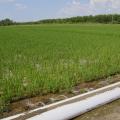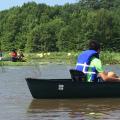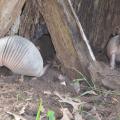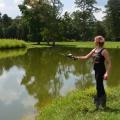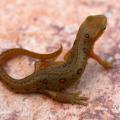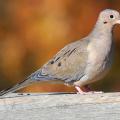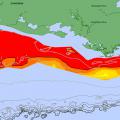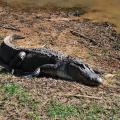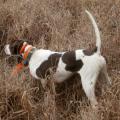Extension Outdoors from 2017
STARKVILLE, Miss. -- As temperatures rise and rainfall declines over the hot summer months, it is important to use our water resources efficiently.
Luckily, there are technologies and innovative strategies that farmers can employ to make every drop of water count.
STARKVILLE, Miss. -- As a child, some of my favorite times were spent outdoors. Sadly, spending time outside is no longer the norm for many people.
STARKVILLE, Miss. -- Whether summer gardens are for beauty or food, this time of year is sure to bring wildlife into close contact with people's property.
Many gardens provide healthy and nutritious food for local critters such as armadillos, raccoons, white-tailed deer, eastern cottontail rabbits and a wide variety of insects. Gardens are usually easy for wildlife to access and offer an inviting buffet with such easy pickings concentrated in one area. All that time and labor you spent during the spring should not be tossed out due to these garden pests.
STARKVILLE, Miss. -- Many Mississippi landowners have tiny ponds that are not ideal for traditional largemouth bass/bluegill management. In ponds less than an acre in size, other species, either by themselves or in combination, can usually provide higher quality fishing opportunities than the traditional bass and bluegill approach.
A great choice for small ponds is to create a hybrid sunfish pond. Hybrid sunfish, sometimes called hybrid bream, are a good option for small ponds because they grow quickly, especially when fed, and they are easy to catch.
RAYMOND, Miss. -- Microplastics, very small plastic particles, in the natural environment have been in the news a lot lately, but there are many steps we can take to reduce this problem.
These tiny, sometimes microscopic, particles come from larger pieces of plastic and fibers from breathable clothing. They have been the focus of much recent media coverage and are the subject of ongoing research, including efforts at Mississippi State University.
STARKVILLE, Miss. -- Stocking ponds with largemouth bass and bluegills is the most common management strategy used in Mississippi, but this combination is not ideal for ponds smaller than one acre.
In these tiny ponds, other species -- either by themselves or in combination -- can usually provide higher quality fishing opportunities than the traditional bass and bluegill approach. One great choice for small ponds is catfish, which provide easy fishing and excellent table fare.
STARKVILLE, Miss. -- With the temperature rising daily, it is getting more common to spot turtles and snakes basking on the roads. Being aware of this change in reptile behavior can help drivers avoid hitting them.
STARKVILLE, Miss. -- Whether fishing, hunting, boating, hiking, photographing or wildlife watching, all outdoor enthusiasts should practice "Leave No Trace."
Leave No Trace is a set of seven easy-to-follow principles meant to reduce manmade negative impacts on the environment.
STARKVILLE, Miss. -- Although water hyacinth is beautiful and quite stunning when in bloom, it is not a desirable plant in ponds.
Water hyacinth floats gracefully on water surfaces. Its inflated, spongy stems feature attractive flower spikes adorned with up to 20 blue, yellow and light-purple flowers. It is common on many of Mississippi's navigable waterways, including the Tennessee-Tombigbee Waterway and the Pearl River drainage. Native to tropical South America, water hyacinths feel right at home with Mississippi's warm summers and fertile waters.
STARKVILLE, Miss. – Small, forested ponds are abundant in Mississippi, and there is a good chance one is somewhere on your back 40.
Most landowners see these small systems as difficult to manage for fish because they are too small, shallow, or weedy, or maybe the trees are too close to the water's edge. Fishing may not be your thing anyway. In these cases, consider managing small, wooded ponds for wildlife.
RAYMOND, Miss. -- Funding and manpower are cited as the most common limiting factors in conducting research, especially for wildlife and fisheries studies, which can cover huge areas, involve secretive animals and collect large quantities of information.
STARKVILLE, Miss. -- Mourning doves are popular game birds and songbirds in North America. Common in urban and suburban environments, they often are seen perched on utility wires or feeding in fallow grain fields or on the ground under bird feeders.
Mourning doves have a plump body, small head, buffy feathers with scattered black wing spots, long tail feathers, and short, pink legs. It is smaller and less colorful than its pigeon cousins that are often seen around city parks, bridges and silos.
STARKVILLE, Miss. -- A new record has been set in the Gulf of Mexico, but it is not one to brag about because it threatens a multibillion-dollar fishing industry.
The most recent Gulf dead zone measured in the summer of 2017 was the largest ever recorded in 32 years of monitoring. It covered 8,776 square miles, which is closer to the size of New Jersey than the average zone size of 5,309 square miles. Reducing the size of the hypoxic zone is important if we want to ensure continued productivity of the Gulf fishery.
STARKVILLE, Miss. -- Those of us with a strong connection to the natural world know that attachment was born and strengthened through personal experiences we had outdoors as children, generally when family members took us outside to spend time, relax or have fun.
A new nationwide program began in 2015 with hopes of increasing access to federal public lands for fourth-grade students, along with the goal of establishing connections to the outdoors. Every Kid in a Park begins its third year on Sept. 1, 2017. Every fourth-grader has easy access to a free pass for admission to public land from Sept. 1 through Aug. 31, 2018.
Now is the time of year when many of us notice the pitter-patter of small feet in our attics or walls.
Complaints of mice in and around homes are common in the fall. The house mouse is one of the most troublesome and costly rodents in the United States. House mice damage structures and contaminate food sources meant for humans, pets, livestock and other animals.
During the fall, both the house mouse, which spends most of its life in human dwellings, and the deer mouse, which spends warm seasons outside, are searching for food and warm shelter to nest and breed during the winter.
STARKVILLE, Miss. -- Thousands of years ago, mastodons, giant ground sloths, saber-tooth cats and short-faced bears roamed the land now called Mississippi. More recently, Carolina parakeets, passenger pigeons and eastern elk lived in the forests and fields surrounding the homes and towns of European settlers living in the Southeast.
All of these animals are now extinct, which means no living individuals remain on the planet. Although climatic changes aided in the extinction of some of these species, others were lost to habitat loss and overharvest.
These are just a few of the many species in the U.S. and around the globe that are extinct. Others are on the brink of extinction. Unless we act, these endangered species may follow the same path as the mastodon and passenger pigeon.
STARKVILLE, Miss. -- Thanks to the careful management and conservation efforts of Mississippi’s state and federal wildlife biologists, alligator populations across the state are thriving.
In fact, Ricky Flynt, alligator coordinator with the Mississippi Department of Wildlife, Fisheries and Parks, said he considers the healthy alligator populations a conservation success story. From the early 1900s through the 1960s, alligators were not protected and were nearly eliminated, he explained. Now, their numbers are high enough to allow limited recreational hunting.
STARKVILLE, Miss. -- Hurricanes Irma and Harvey recently blew through the Southeast and into the history books, bringing destructive winds and leaving devastating floods in their wakes.
Hurricane Harvey brought record-breaking rainfall to the continental U.S. -- 51.88 inches in a single event. After the severe winds left a path of destruction, flooding continued for days after Harvey made landfall and moved along the Texas coast.
STARKVILLE, Miss. -- As hunting season begins, there are several issues landowners need to keep in mind when they allow sportsmen to use their property for hunting, fishing or other recreation.
Landowners should consider accident liability, lease fees and a legal contract for the arrangement. In a recreational hunting lease, the landowner grants access to his or her land for a certain period of time in exchange for fees or services rendered.
STARKVILLE, Miss. -- Feral cat control has been hotly debated in recent years because of concerns over lethal measures to limit the numbers of animals many consider to be pets.
Many of us have experienced the feel-good act of feeding or housing a stray cat. With so many cats roaming freely, how can we tell if a cat is wandering, homeless or feral? Knowing the difference can allow you to take the most humane action in helping the cat.

